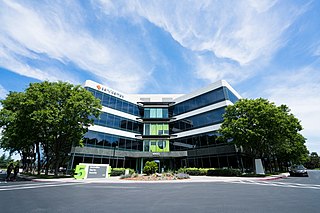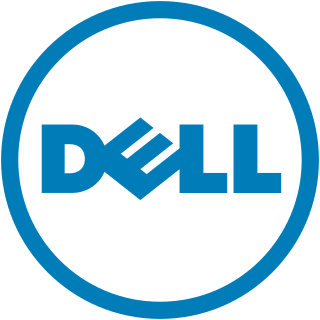Customer relationship management (CRM) is a process in which a business or another organization administers its interactions with customers, typically using data analysis to study large amounts of information.

Nokia Corporation is a Finnish multinational telecommunications, information technology, and consumer electronics corporation, originally established as a pulp mill in 1865. Nokia's main headquarters are in Espoo, Finland, in the Helsinki metropolitan area, but the company's actual roots are in the Tampere region of Pirkanmaa. In 2020, Nokia employed approximately 92,000 people across over 100 countries, did business in more than 130 countries, and reported annual revenues of around €23 billion. Nokia is a public limited company listed on the Nasdaq Helsinki and New York Stock Exchange. It was the world's 415th-largest company measured by 2016 revenues, according to the Fortune Global 500, having peaked at 85th place in 2009. It is a component of the Euro Stoxx 50 stock market index.
Qt Group Plc is a global software company headquartered in Espoo, Finland. It was formed following the acquisition of Qt by Digia, but was later spun off into a separate, publicly traded company.
Thoughtworks Holding, Inc. is a publicly-traded, global technology company with 49 offices in 18 countries. It provides software design and delivery, and tools and consulting services. The company is closely associated with the movement for agile software development, and has contributed to open source products. Thoughtworks' business includes Digital Product Development Services, Digital Experience and Distributed Agile software development.
Software as a service is a cloud computing service model where the provider offers use of application software to a client and manages all needed physical and software resources. Unlike other software delivery models, it separates "the possession and ownership of software from its use". SaaS use began around 2000, and by 2023 was the main form of software application deployment.

Tietoevry Corporation is a Finnish IT software and service company providing IT and product engineering services. Tietoevry is domiciled in Espoo, Finland, and the company's shares are listed on the NASDAQ OMX Helsinki, NASDAQ OMX Stockholm and Oslo Stock Exchange. Tietoevry has approximately 24,000 employees across 20 countries, and has customers in the energy, forestry, banking, healthcare and public sectors.

Salesforce, Inc. is an American cloud-based software company headquartered in San Francisco, California. It provides applications focused on sales, customer service, marketing automation, e-commerce, analytics, artificial intelligence, and application development.
In software engineering, offshore custom software development consists in offshoring the software development process in a country where production costs are lower, thus decreasing budget spending.
TechnologyOne Limited is an Australian enterprise software company founded in 1987. The company is headquartered in Fortitude Valley in Brisbane, Australia, with other offices in United Kingdom (UK), New Zealand, South Pacific and Asia. It is listed on the Australian Securities Exchange with the symbol TNE and is a constituent of the ASX 200 index.

Here Technologies is a Dutch multinational group specialized in mapping technologies, location data, and related automotive services to individuals and companies. It is majority-owned by a consortium of German automotive companies and American semiconductor company Intel whilst other companies also own minority stakes. Its roots date back to U.S.-based Navteq in 1985, which was acquired by Finland-based Nokia in 2007. Here is currently based in The Netherlands.
Acumatica, Inc. provides cloud and browser based enterprise resource planning software for small and medium-sized businesses. The company is headquartered in Bellevue, Washington, in the Seattle metropolitan area.
Exigen Services recently merged and renamed to Emergn. Insurance Software production under Exigen Insurance Solutions has separated and was renamed to EIS.
Veracode is an application security company based in Burlington, Massachusetts. Founded in 2006, it provides SaaS application security that integrates application analysis into development pipelines.

Zoho Corporation is an Indian multinational technology company that makes computer software and web-based business tools. It is best known for the online office suite offering Zoho Office Suite. The company was founded in 1996 by Sridhar Vembu and Tony Thomas and has a presence in seven locations with global headquarters in Chennai, Tamil Nadu, India, and corporate headquarters outside of Austin in Del Valle, Texas. Radha Vembu, Sridhar Vembu's sister, owns a majority stake in the company.

Taleo Corporation was a publicly traded database vendor based in Dublin, California, which was acquired by Oracle in 2012. Taleo's product offerings primarily focus on talent acquisition (recruitment), performance management, learning and development, and compensation management. These capabilities combine to provide what Taleo calls "Talent Intelligence" — an enhanced level of insight into candidates and employees. Taleo sells its Human resource management system products entirely via a software-as-a-service (SaaS) model, in which all software and information resides in data centers operated and secured by Taleo.

Orange and Bronze (O&B) is a privately owned computer software development company based in the Philippines. The company delivers software consulting, product engineering, and IT training services with a focus on Java software development. O&B specializes in developing and deploying web applications using Java-based frameworks and technologies such as Spring (framework), Grails (framework), Hibernate (Java), Google Maps API, Google App Engine, and Android.
Visma Solutions is a Finnish joint stock company, which offers SaaS business software for companies. The company produces professional services automation software, E-accounting software, budgeting and forecasting software, e-invoicing service software, and an online signature service. Visma Solutions is part of the Visma group.

ServiceMax is a Service Execution Management company. It provides a cloud-based software platform designed to improve the productivity of complex, equipment-centric service execution for OEMs, operators, and 3rd-party service providers.

Dell Software was a former division of Dell with headquarters in Round Rock, Texas, United States. Dell Software was created by merging various acquisitions by Dell Inc., the third-largest maker of PCs and now a privately held company, to build out its software offerings for data center and cloud management, information management, mobile workforce management, security and data protection for organizations of all sizes.
Questback is an online survey and feedback software company, headquartered in Oslo, Norway. The company offers online data collection and analysis solutions for Enterprise Feedback Management, including market research, customer satisfaction and loyalty, product and concept testing, employee evaluations, people analytics and online feedback. Questback serves enterprises in more than 50 countries, with thousands of customers across the globe, and works with over one-third of the companies on the Forbes top 100 list.









